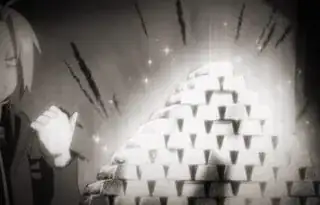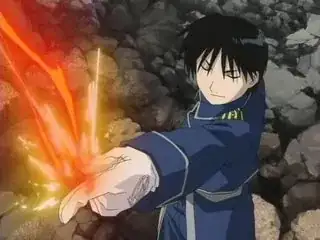The alchemy in Fullmetal Alchemist is based on a real alchemy. How similar is the alchemy in the anime to the alchemy in real life history? When and how do they diverge?
1 Answers
In their concept, they are very much alike. In their implementation, they are starkly different.
Similarities
First, it is very important to say that there is hardly a single definition of alchemy. Some of its first mentions are from texts hundreds of years old, but most highlight three things: Transmutation of base metals (usually to gold), creating a universal cure, and creating a universal solvent.
Using FMA alchemy, it is possible to transmute base metals into gold (as Ed did in Yoki's village), and through proper use of alchemy, healing and medicinal applications are possible. Other elemental transmutations, which were less sought by real-life alchemy but still present in research, are also done.
Real-world alchemy was often done in the pursuit of the philosopher's stone, a legendary substance which was believed to provide everlasting life (as it did in Harry Potter and the Philosopher's Stone); the stone in FMA did this, more or less, as well.
Differences
This philosopher's stone was originally believed to be produced through the magnum opus. This is never seen (nor even mentioned) in FMA; instead, all alchemy is done through a transmutation circle (with a few exceptions), including creation of the stone. Transmutation circles are not strictly based on any tradition of alchemy (though they use alchemical symbols and other similar glyphs).
The philosopher's stone ingredients differ also:
In real life, the origin of the stone was that it was possessed by Adam, who had received it from God, and its ingredients were never discovered. In FMA, the stone is made of human life.
Similar to the circles, there is no real mention of using hands to physically guide energy in alchemy. There were not dreams of making weapons out of the floor or using the techniques for war. Alchemy was done mostly in a lab, using techniques like the magnum opus to create chemicals and other such processes. It's no surprise, then, that the believed art of alchemy was for science and advancement of oneself, so much so that it founded today's chemistry (and through Paracelsus—mentioned below—chemical medicine).
The sources of energy for the transmutations are also different; in FMA, they use tectonic energy and the "Dragon's Pulse" for Alkahestry. In real life, the energy comes from chemical bonds and thermal energy.
Alkahestry
The universal solvent I mentioned above is called Alkahest, which is the base of the name Alkahestry (used in the English dub).
Generally, Alkahestry is much closer to what we think of as alchemy from the real world. Its purpose—medicinal usage—is much closer to the medical and chemical applications that real-world alchemy sought. In the alchemical notes that they delve into later into the series, there is a drug, "rasayana" (based on the Indian term rasayana), which is used for longevity and which is stated to "transform all metals to gold and restore youth to the elderly"; in that way, this substance appears to be much like the philosopher's stone concept seen in real life.
However, Alkahestry (like normal FMA alchemy) uses hand gestures and circles instead of actual chemicals; also, as mentioned above, its source of energy (the "Dragon's Pulse") is something that is not found in ancient real-world alchemy.
Overall
FMA's alchemy and real-life alchemy share some things:
- The overall concept of transmuting elements, as well as transmuting to gold
- The creation of a philosopher's stone
- The ability to cure through alchemy
- The pursuit of everlasting life
They also have quite a few differences:
- The process of creating the philosopher's stone
- The philosopher's stone ingredients
- The transmutation circles
- The process of doing alchemy at all (using the body rather than a lab)
- The source of energy (tectonic energy or the "Dragon's Pulse" rather than chemical energy)
- Their purpose (real-life alchemy pursued a goal more like Alkahestry)
-
1ed does not transmute the bars into gold bars, but transmutes them, so the innate gold forms a thin layer on the gold bar itself, meaning he did not transmute the (whatever metal it was) into gold – Vogel612 May 11 '13 at 19:17
-
@Vogel612 Yes, exactly. But there is still gold on the outside which was created by Ed; it just wasn't on the inside. (Not only that, but there is a rule that alchemists are not allowed to create gold for economic reasons.) – Cattua May 11 '13 at 19:26
-
1i thought he had collected it as elemental particles from the earth beforehand, like eragon in eragon3 when he creates the wedding rings for roran and katrina, but when you say (it's been a while since i watched maybe i am confusing the details ;)) – Vogel612 May 11 '13 at 19:39
-
1Correct me if I'm wrong but I thought that the philosopher stone in real life was supposedly used for transmuting base metals to gold not prolonging life which was suppose to have been discovered by Nicholas flamel who also obtained immortality from the elixir of life? – Aug 12 '13 at 19:06
-
@RaulHerrera Partly yes, partly no. The philosopher's stone was thought to be that which was able to create the elixir of life (as well as transmutation of base metals to gold). – Cattua Aug 12 '13 at 19:17
-
Correct me if I'm wrong but I thought that the philosopher stone in real life was supposedly used for transmuting base metals to gold not prolonging life which was suppose to have been discovered by Nicholas flamel who also obtained immortality from the elixir of life? – Aug 12 '13 at 19:06

